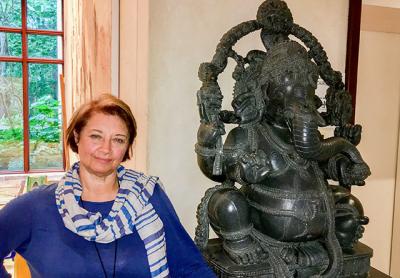Journey to India Completes a Circle

Since the notion of reincarnation looms large in India, it might be safe to say that Debra McCall, the director of teacher certification and professional development at the Ross School in East Hampton, could have been Indian in another life. As a certified movement analyst and a multiple recipient of National Endowment for the Arts fellowships for choreography, it would be even safer to say that in her previous life she could have been a devadasi — a temple dancer who, over two millenniums ago, dedicated her life to the sacred movement of dance.
Ms. McCall was named recipient of the 2017-18 Fulbright-Nehru Academic and Professional Excellence Award for a project that will entail the documentation of thousand-year-old frescoes and dance reliefs on the walls of the Thillai Nataraja temple, a major shrine of Lord Shiva worship, in Tamil Nadu, India’s southernmost state. She will head to the subcontinent on Oct. 1 to conduct her research, staying for six months near the famous temple.
India’s lure first struck Ms. McCall in 1994, when she met the late Indrani Rahman, who taught Bharatanatyam — an ancient and revered style of Indian dance — at the Juilliard School and Harvard University. Ms. Rahman was considered the foremost Indian classical dancer in the West and performed for dignitaries such as John F. Kennedy, Queen Elizabeth II, Emperor Haile Selassie, and Chairman Mao.
“It was near the end of her tenure at Juilliard that I invited her to teach a small group in my loft in the city,” said Ms. McCall. “We were honored and excited when she agreed. She taught us Shiva’s dance of creation, which I later taught to several groups of students at Ross.”
It was during those lessons in her loft that Ms. McCall learned of the Thillai Nataraja temple, one of the first in India to worship the dancing form of Shiva, as depicted by the most widespread icon of Hinduism: the deity dancing in a ring of fire. Consequently, the temple is only one of two with reliefs detailing all 108 karanas, or postures. Often mistaken as mere architectural embellishments, they are, in fact, the defining lexicon of India’s classical Bharatanatyam dance.
“I always wanted to visit the temple,” said Ms. McCall. Instead, she arrived in East Hampton in 1995 to join the Ross School, where for 22 years she has helped write the school’s curriculum, served as the dean of cultural history, and taught world dance.
However, in 2015, Ms. McCall’s personal universe was shattered when her 25-year-old son died in an accident while in California. At first, she threw herself into her work to cope with her profound sorrow, but soon thereafter she knew she needed a sabbatical in order to make sense of it all.
In February 2016, she accompanied a group of Ross students on a trip to India for the first time. Her period of healing was to follow after her charges returned to the United States. She stayed behind to explore the vast country that had bewitched her for so long. Initially, she intended to visit the sacred temple in Tamil Nadu for three or four days.
“I stayed for 10 days,” she said recently. “I walked into that temple and it was like a dream. There was a dance festival going on and the dance of creation was being performed.” She returned to the temple several times, including this February for Maha Shivaratri, the annual Hindu festival to honor Lord Shiva. Befriending the Tamil and Sanskrit-speaking caste of Deekshithar priests who preside over the temple, as well as local scholars and families, Ms. McCall delved deeper into the great history behind the relief carvings.
Upon returning to East Hampton, she applied for the Fulbright-Nehru Fellowship, outlining her plan: to video, photograph, and chronicle all 108 karanas. She will also document the intangible culture of the temple, with its rituals, festivals, and the history of its priests, who showed her manuscripts written on palm leaves that are over 1,000 years old and housed in the temple. She hopes to translate these, too, for which she must learn some Sanskrit.
Her goal is to compile a book, she said, to leave behind at the temple and to present to UNESCO, or another similar organization, to help the temple obtain status for the preservation of its unique cultural treasures. While there, Ms. McCall will be affiliated with the neighboring Annamalai University as a visiting scholar.
The Fulbright program, founded in 1946 by United States Senator J. William Fulbright, operates in over 160 countries around the world and grants merit-based educational exchange programs for students, scholars, teachers, and professionals who are competitively selected to study and conduct research abroad. This is Ms. McCall’s first Fulbright and her seventh fellowship, most of which have been awarded through the National Endowment for the Arts and Humanities.
Conveying the Indian concept of the never-ending cycle of time, Ms. McCall feels that her son, Adrian, will be with her on this journey. “He knew how much I loved India,” she said. “He would always say that when he made enough money, he would buy me a small place in India because that’s where I belong.”
